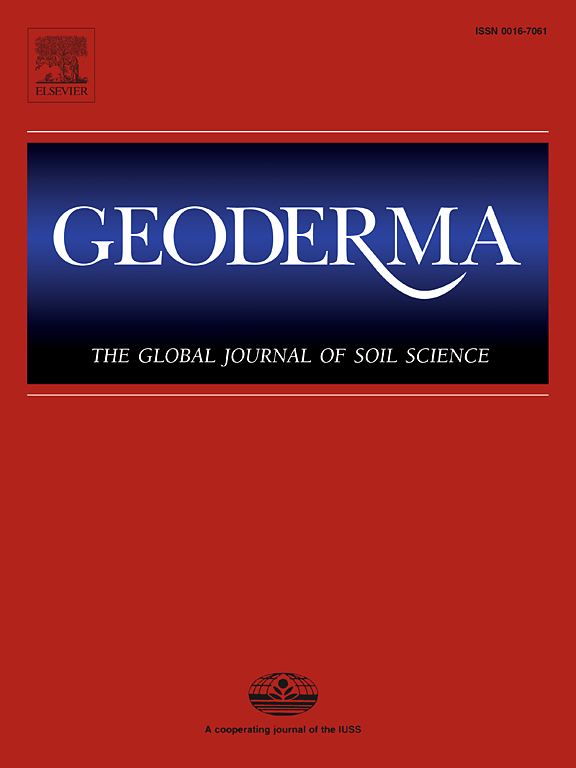QuantiSlakeTest测定土壤结构稳定性:与土壤孔隙度、水稳性团聚体组分和土壤化学性质的联系
IF 5.6
1区 农林科学
Q1 SOIL SCIENCE
引用次数: 0
摘要
最近,QST (QuantiSlakeTest)被开发出来,用于记录完整土壤样品在淹没过程中的质量损失或增加,但目前尚不清楚slaketest与土壤结构的定量关系。本研究的目的是确定QST是否可以作为一种快速且经济有效的替代现有结构测试的方法,并且可以与土壤孔隙度(由土壤保水曲线决定)或通过湿筛获得的水稳性骨料(WSA, >250µm)分数相关联。这是在比较研究中进行的22土壤收集耕地和牧场具有不同的性质。随着土壤有机碳(SOC)含量的增加,QST中团聚体破碎造成的质量损失越小(r = 0.59),而SOC与WSA分数(r = 0.45)或相对中宏观孔隙度(>;30µm;r = 0.53)。WSA与土壤中草酸盐可提取铁(Feox)有很强的相关性(r = 0.63),与早期的研究一致,但Quantislake参数没有发现这种趋势,这表明QST捕获的土壤结构与湿法筛分不同。质量损失随相对中宏观孔隙率的增加而减小(r = 0.68),表明大孔隙比例较大的土壤比平均孔径较小的土壤抗团聚体破碎能力更强。在10种土壤的一个子集中,记录了每个Kopecky环内的根质量。结果表明,土壤QST和相对微孔隙度与土壤根系质量呈显著相关(r分别为0.77和0.71),表明根系对土壤结构的重要性。与其他两种方法的参数相比,Quantislake参数在采样重复之间具有更大的变异性(CV = 75—100%)。然而,Quantislake参数在不同土壤中的差异更大,导致其统计能力与湿筛和保水曲线相似。结果表明,在未受扰动的土壤中,QST是一种有用的土壤结构附加指标。它甚至比湿筛法更能显示介孔,因此更适合于研究,例如优先流动。本文章由计算机程序翻译,如有差异,请以英文原文为准。
The soil structural stability determined by the QuantiSlakeTest: Linkage with soil porosity, water-stable aggregate fractions and soil chemical properties
Recently, the QuantiSlakeTest (QST) was developed which records mass loss or gain of intact soil samples during submergence, but it is yet unclear how slaking relates quantitatively to soil structure. This study was set up to determine if the QST can be a quick and cost-effective alternative to established structure tests and can be linked to soil porosity, determined by the soil water retention curve, or to the water-stable aggregate (WSA, >250 µm) fraction obtained by wet sieving. This was performed in a comparative study with 22 soils collected in arable and pasture land with contrasting properties. The mass loss due to aggregate breakdown in the QST was smaller as soil organic carbon (SOC) content increased (r = 0.59), while SOC correlated weaker with the WSA fraction (r = 0.45) or with relative meso + macroporosity (> 30 µm; r = 0.53). The WSA correlated strongly to oxalate extractable Fe (Feox) in the soil (r = 0.63), conforming to earlier studies, but no such trend was found for Quantislake parameters, indicating that the QST captures a different aspect of soil structure than the wet sieving. The mass loss in the Quantislake decreased with increasing relative meso + macroporosity (r = 0.68), suggesting that soil resistance to aggregate breakdown is higher in soils with a large fraction of large pores than in soils with smaller average pore sizes. In a subset of 10 soils, root mass within each Kopecky ring was recorded. It showed that the QST and relative microporosity strongly correlated with the root mass in the sample (r = 0.77 and 0.71, respectively), showing the importance of roots on soil structure. The Quantislake parameters have a much larger variability among sampling replicates (CV = 75–––100 %) than the parameters of the two other methods. However, the Quantislake parameters differed much more among soils, leading to similar statistical power as wet sieving and the water retention curves. It is concluded that the QST is a useful additional index of soil structure in undisturbed soils. It even outperforms the wet sieving method to indicate mesoporosity and is thus better suited for studying, e.g., preferential flow.
求助全文
通过发布文献求助,成功后即可免费获取论文全文。
去求助
来源期刊

Geoderma
农林科学-土壤科学
CiteScore
11.80
自引率
6.60%
发文量
597
审稿时长
58 days
期刊介绍:
Geoderma - the global journal of soil science - welcomes authors, readers and soil research from all parts of the world, encourages worldwide soil studies, and embraces all aspects of soil science and its associated pedagogy. The journal particularly welcomes interdisciplinary work focusing on dynamic soil processes and functions across space and time.
 求助内容:
求助内容: 应助结果提醒方式:
应助结果提醒方式:


